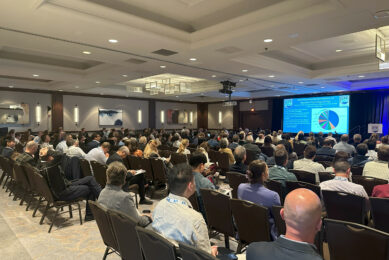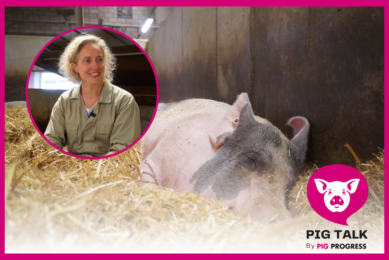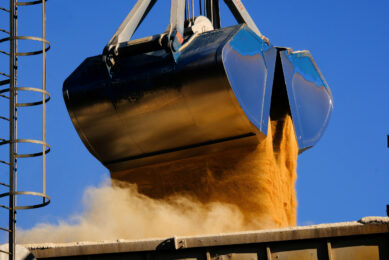Indigestion: An overlooked factor in animal nutrition?
![Indigestible raw materials do not contribute to support the growth and health of young pigs. [Photo: Mark Pasveer]](https://www.allaboutfeed.net/app/uploads/2020/12/001_195_rb-image-2667369.jpeg)
Many articles on young animal feed composition focus on digestibility of ingredients. It is interesting, however, to take the opposite view. What happens when trying to measure indigestibility and thus quantify what is in the feed that young animals don’t need?
When evaluating feed ingredients, digestibility of nutrients as a measure of quality and potential in feed formulation is typically used. These values are published in various nutrition guides and are often the target of research projects to verify published data or shed light on new hypotheses.
It is important information when formulating feed to provide the nutrient requirements for a given animal.
However, in this article, a different view is taken of the nutrient perspective: indigestibility. In this text, indigestibility is used to describe the undigested protein in the raw materials or the reciprocal of digestibility. This is related to what happens further along in the digestive tract, after easily digested nutrients have been absorbed, to the fraction that is not digested.
A discussion of all the nutrients and animal species or ages would require many pages. Instead this article zooms in on protein and piglets as an example, not only because there is interesting data with regard to this perspective, but also because protein is the most costly of the major nutrients and is always susceptible to scrutiny. Indigestible protein may cause potential gut health problems which makes it interesting from a health perspective as well as from a growth perspective. Finally, there is an energy cost involved in excreting nitrogen from de-aminated amino acids.
Piglets are of interest as below data shows that the indigestible protein fraction is larger in young piglets (<20 kg) during the first few weeks post-weaning. subsequently, the indigestible fraction drops over the next few weeks to a level which resembles what we know from pigs over 25 kg (>Tables 1-3).
Digestibility develops with animal age
The data in Table 1 shows there is a significant difference in the standardised ileal digestibility (SID) of protein among soy-based ingredients. The data comes from all published values for the individual feedstuffs. However, comparing the SID crude protein values for each individual ingredient for pigs weighing less than 20 kg, there is a difference for soybean meal 48% of 4.5% units, but for enzyme-treated soybean meal, no difference is found (Table 2). The reason is that only results with pigs lighter than 20 kg have been published.
In Table 3, SID of crude protein values for soybean meal 48%, grouped according to weight are reported. The data in Table 3 is in line with the difference found between results in Table 1 and Table 2 for soybean meal 48%. Going from piglets (5.6-12.2 kg) to growing pigs (23.2-50.0 kg), an increase in SID of 8.8% units is observed.
Digestibility of amino acids
These values listed in Tables 1-3 are in agreement with a report set up by Ron Ball and Soenke Moehn, University of Alberta, Canada, 2015. They found that the SID of amino acids was significantly lower in weaned piglets (end weight 8.1 kg) in comparison to grow-finishing pigs for barley, wheat, maize, peas and soybean meal. According to them, the mean SID of amino acids for canola meal was highest for weaned piglets compared to the other ingredients they reported. The researchers’ explanation for the differences in SID of amino acids for these ingredients in weaned piglets in comparison to grow-finishing pigs were due to the higher relative endogenous losses in the younger pigs. Similar findings have been reported for broilers; older birds show higher SID of amino acids compared to younger birds.
Figure 1 shows the National Research Council’s (2012) recommendation for SID of lysine for pigs. The lines are divided into three different straight lines, with two break points. The slope of the line for piglets less than 11 kg is clearly different from the slope for piglets up to 37.5 kg (median of the interval 25-50 kg). The slope of the line from 37.5 kg to slaughter is again different from the first two lines. The steep slope from 5-11 kg can be explained largely by a lower SID of amino acids in soybean meal, since most of the studies conducted to estimate the amino acid requirements in piglets used soybean meal as the main protein source.
Sensitivity to anti-nutritional factors
In addition to the differences in endogenous losses between young animals and older animals, there is also the sensitivity to anti-nutritional factors. Crude protein (N x 6.25) can be calculated into nitrogen from amino acids and from non-protein nitrogen (NPN), see Figure 2.
As the figure shows, the digestibility of the amino acid fraction varies resulting in various amounts of undigested amino acid entering the large intestine. But apart from the indigestibility of these raw materials, they also contribute a non-protein nitrogen (NPN) fraction to the large intestine. Those two fractions of the original crude protein from the feed can be utilised in the gut by proteolytic bacteria causing growth and potential risk of an imbalance in the microflora with subsequent diarrhoea. The NH3 formed in the gut is absorbed and contributes to the nitrogen load which has to be removed by the liver and excreted from the kidneys via urine; all of which costs energy and takes up capacity in the liver from other metabolic outputs which could have supported growth and health.
In conclusion, the indigestibility and NPN content of raw materials do not contribute to support the growth and health of young animals. They do, however, add to the health risks and maintenance costs of those same animals.
References available on request.












